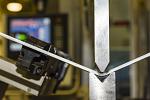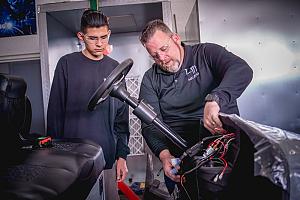- FMA
- The Fabricator
- FABTECH
- Canadian Metalworking
Categories
- Additive Manufacturing
- Aluminum Welding
- Arc Welding
- Assembly and Joining
- Automation and Robotics
- Bending and Forming
- Consumables
- Cutting and Weld Prep
- Electric Vehicles
- En Español
- Finishing
- Hydroforming
- Laser Cutting
- Laser Welding
- Machining
- Manufacturing Software
- Materials Handling
- Metals/Materials
- Oxyfuel Cutting
- Plasma Cutting
- Power Tools
- Punching and Other Holemaking
- Roll Forming
- Safety
- Sawing
- Shearing
- Shop Management
- Testing and Measuring
- Tube and Pipe Fabrication
- Tube and Pipe Production
- Waterjet Cutting
Industry Directory
Webcasts
Podcasts
FAB 40
Advertise
Subscribe
Account Login
Search
New ISO standards for green machine tools
Energy efficiency is key
- July 27, 2018
- Article
- Shop Management
When the topic of green manufacturing comes up, energy-efficient machine tools are not usually what is envisioned. Yet machine tools contain motors and auxiliary components that can place large energy demands during their operations. Fortunately, a new series of International Organization for Standardization (ISO) standards can help measure energy consumed and improve machine design and performance.
Machine tools are complex, power-driven industrial devices. They encompass an array of tools and their accessories for cutting and forming metal.
Machine tools, such as presses, obviously use different forms of energy, including electrical, hydraulic, and compressed air. Energy is consumed in the cooling and lubrication systems as well.
Therefore, the energy demand of a machine tool is a key consideration for investment, but it does not stand alone. The performance of a machine tool is multidimensional, comprising its economic value, technical specifications, and operating requirements, which are influenced by the specific application. That explains why calculating the ecological footprint for these products can be challenging.
As natural resources become more taxed, environmental performance criteria for machine tools need to be defined and the use of these criteria specified.
ISO has recently published the first two parts of a new, international standard for the environmental evaluation of machine tools. It proposes to analyze machine tools by their delivered functions to highlight their commonalities despite the variations in existing machine tool types.
ISO 14955-1. Environmental evaluation of machine tools—Part 1: Design methodology for energy-efficient machine tools addresses the energy efficiency of machine tools during their working lives. It identifies the main functions and machine tool components that are responsible for energy demand during the use phase. Then these components are compared with their previous versions or with state-of-the-art versions for their future improvement.
ISO 14955-2. Environmental evaluation of machine tools—Part 2: Methods for measuring energy supplied to machine tools and machine tool components supports the energy-saving design methodology according to ISO 14955-1 by providing practical methods for measuring the energy supplied to machine tools.
Ralf Reines, convenor of the ISO/TC 39/WG 12 technical committee that developed the standards, explains: “This is, to my knowledge, the only standard concerning this topic that is tailored for machine tools. It covers the topic in a way that it can be applied to each and every machine tool, despite the fact that the product group of machine tools is extremely diverse.” Machine tooling comprises many different methods and technologies, such as blanking, stamping, forming, automation, grinding, laser processing, and material movement. In addition, part sizes must be accounted for. The standard focuses on the energy used to achieve higher environmental performance without sacrificing technical performance.
According to “Market Report 2016” by the German Machine Tool Builders’ Association, the world production of machine tools stands at EUR 67.7 billion ($79 billion). The increasing demand for machinery and production systems to be more energy-efficient is a relatively new challenge for machine designers. Now, with the new ISO 14955 series, energy efficiency is likely to become an increasingly important quality attribute of modern machine tools.
ISO 14955-1 and ISO 14955-2 were developed by ISO technical committee ISO/TC 39, Machine Tools, with secretariat held by SNV, ISO’s member for Switzerland.
International Organization for Standardization (ISO) www.iso.org/about-us.html
subscribe now

The Fabricator is North America's leading magazine for the metal forming and fabricating industry. The magazine delivers the news, technical articles, and case histories that enable fabricators to do their jobs more efficiently. The Fabricator has served the industry since 1970.
start your free subscription- Stay connected from anywhere

Easily access valuable industry resources now with full access to the digital edition of The Fabricator.

Easily access valuable industry resources now with full access to the digital edition of The Welder.

Easily access valuable industry resources now with full access to the digital edition of The Tube and Pipe Journal.
- Podcasting
- Podcast:
- The Fabricator Podcast
- Published:
- 05/14/2024
- Running Time:
- 62:12
Cameron Adams of Laser Precision, a contract metal fabricator in the Chicago area, joins the podcast to talk...
- Trending Articles
What software automation means for custom fabrication

Why employee-owned companies make sense in manufacturing

Nucor’s weekly steel price announcement continues to rattle markets

Press brakes, panel benders, and flat blank calculations

Washington artist creates life-size elk sculptures

- Industry Events
Laser Welding Certificate Course
- May 7 - August 6, 2024
- Farmington Hills, IL
World-Class Roll Forming Workshop
- June 5 - 6, 2024
- Louisville, KY
Advanced Laser Application Workshop
- June 25 - 27, 2024
- Novi, MI
Precision Press Brake Certificate Course
- July 31 - August 1, 2024
- Elgin,



























